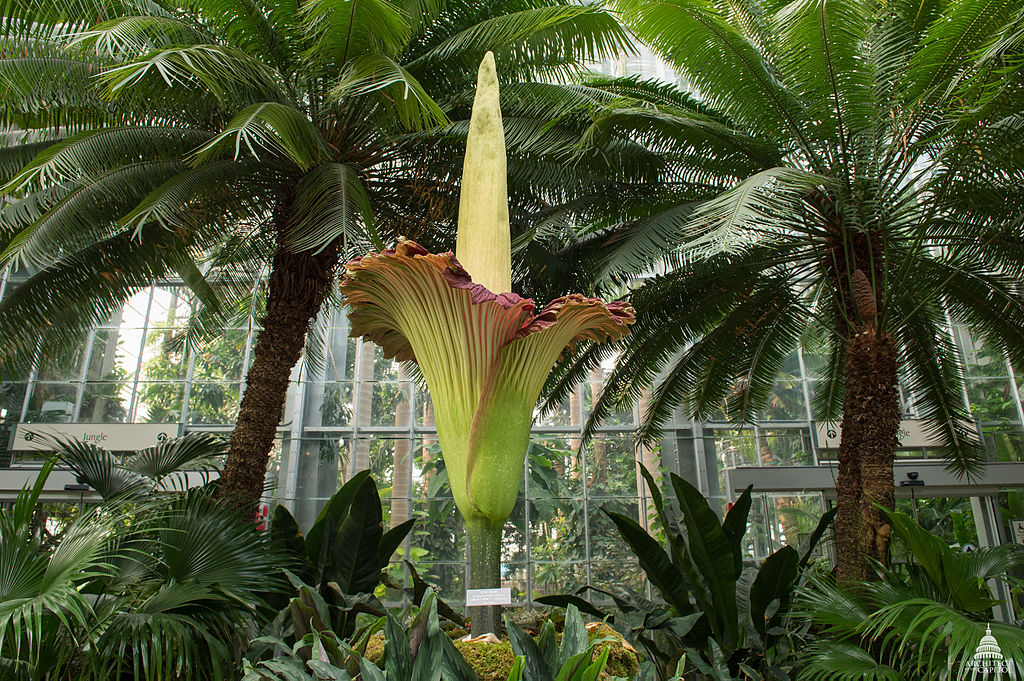How the Corpse Flower just made history

With the biggest inflorescence of any unbranched flowering plant in the world, the corpse flower, officially known as Amorphophallus titanium, is already an amazing thing to look at. Unfortunately, the other quality that makes the plant unique is the flower that gives it its name.
Putting off a strong scent of a rotting carcass that attracts flies and beetles to act as its pollinators, the corpse flower is also known as a carrion flower. So despite its gross smell, what is so special about a corpse flower?

Corpse Flower facts
- It is really tall. And I do mean really tall. The inflorescence, which is a cluster of flowers on a stem, by itself can easily grow to over 10 feet tall. The leaves can reach 20 feet tall and 16 feet across. It can also weight more than 100 pounds, making it just big and really heavy.
- Blooming takes a long time. This is why the corpse flower is making news recently. It can take around 10 years of growth and care before the plant can begin to bloom. Once a flower has bloomed, it may begin to bloom more often, about once every three years, or it could still take another 10 years before it blooms a second time. There is no way to know which plant is more likely to bloom faster than others.
- The blooms do not hang around. Even though it takes a decade to actually bloom, the flower will then begin to wilt within the first 12 hours and close within 24 hours. So even though the plant has waited so many years before it finally bloomed, it is short-lived, making the occurrence a short treat that could easily be missed if it wasn’t for the smell.
- The plant smells truly awful. The corpse flower is trying to imitate rotting meat in order to attract beetles and flies to come to it to pollinate the flower. The smell itself is horrible, full of decay and rot and the flower is red with an odd meat-like texture to it to complete the illusion.
- It grows like most plants. Despite the unusual nature of the plant, a corpse flower does not require any special treatment in order to grow. As is the standard with most plants, sunlight, water, and good soil promote the best growing environment.
- It was given another name: Sir David Attenborough gave the flower the name Titan Arum as the literal translation of the official name was considered too rude for TV audiences.
So now that you know the gist of what a corpse flower is about, you may understand the rarity of what went on in August at the U.S. Botanic Garden in Washington D.C.. Unseen before in the United States, there were three corpse flowers in bloom at the same time.
The smell was without doubt unprecedented as one flower smells bad, but three must be terrible. The smell itself only lasts about 8 hours though, giving you a few hours to observe the flower without smelling it.

While the concept of the flower is a bit gross, it is incredibly fascinating and entirely unique. But unfortunately, due to its unusual nature, the plant is considered “vulnerable”. That means there are not many in the wild, but enough to sustain itself. The plant is native to Sumatra and Indonesia, so seeing it blooming freely in North America is an uncommon occurrence.
Botanic enthusiasts flocked to the garden to get a whiff of the buds and blooms and take in the giant flowers in person. Since the plants will not bloom again for years, it makes perfect sense that people who like the rarity would want to see it, however, I would hope that no one would love to really smell it.
If you have any comments then please drop us a message on our Outdoor Revival Facebook page
If you have a good story to tell or blog let us know about it on our FB page, we’re also happy for article or review submissions, we’d love to hear from you.
We live in a beautiful world, get out there and enjoy it. Outdoor Revival – Reconnecting us all with the Outdoors.
